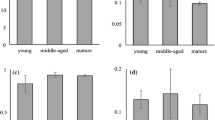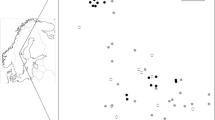Abstract
In Fennoscandian boreal forests, aspen (Populus tremula) is one of the most important tree species for biodiversity. In this study we explore how occupancy and density of beetles associated with dead aspen are related to habitat patch size and connectedness in a 45,000 ha boreal managed forest landscape in central Sweden. Patch size was estimated as amount of breeding substrate and connectedness as crown cover of living aspen in the surrounding landscape. The beetles were sampled by sieving of bark or by inspection of species-characteristic galleries in 56 patches with dead aspen. Six of nine aspen-associated species (Xylotrechus rusticus, Ptilinus fuscus, Mycetophagus fulvicollis, Cyphaea curtula, Homalota plana and Endomychus coccineus) showed a positive significant relationship between habitat patch size and occupancy. For all these species, except C. curtula, there was also a significant positive relationship between patch size and density. Connectedness was not retained as a significant variable in the analyses. Species not defined as aspen-associated constituted a significantly larger proportion of the total density of individuals of saproxylic beetles in smaller habitat patches than in larger patches. Richness of aspen-associated species was positively related to habitat patch size. Efforts in the managed forest should be directed towards preserving and creating larger patches of living and dead aspen trees and increasing the amount of aspen at the landscape level.





Similar content being viewed by others
Abbreviations
- CWD:
-
Coarse woody debris
References
Ahti T, Hämet-Ahti L, Jalas J (1968) Vegetation zones and their sections in Northwestern Europe. Annales Botanici Fennici 5:169–211
Andrén H (1994) Effects of habitat fragmentation on birds and mammals in landscapes with different proportions of suitable habitat: a review. Oikos 71:355–366
Andrén H (1996) Population responses to habitat fragmentation: statistical power and the random sample hypothesis. Oikos 76:235–242
Angelstam P, Wikberg P-E, Danilov P, Faber WE, Nygrén K (2000) Effects of moose density on timber quality and biodiversity restoration in Sweden, Finland, and Russian Karelia. Alces 36:133–145
Anonymous (2000) Svensk FSC-standard för certifiering av skogsbruk. Svenska FSC-Rådet, Uppsala
Anonymous (2009) Forestry statistics 2009. Official statistics of Sweden. Swedish University of Agricultural Sciences, Umeå
Ås S (1993) Are habitat islands islands? Woodliving beetles (Coleoptera) in deciduous forest fragments in boreal forest. Ecography 16:219–228
Baille J, Hilton-Taylor C, Stuart SN (2004) 2004 IUCN red list of threatened species: a global assessment. International Union for Conservation of Nature, Cambridge, UK
Bowman J, Cappuccino N, Fahrig L (2002) Patch size and population density: the effect of immigration behaviour. Conserv Ecol 6:9
Burke DM, Nol E (2000) Landscape and fragment size effects on reproductive success of forest-breeding birds in Ontario. Ecol Appl 10:1749–1761
Dahlberg A, Stokland JN (2004) Vedlevande arters krav på substrat. Rapport No. 7. Skogsstyrelsen, Jönköping
Drakare S, Lennon JJ, Hillebrand H (2006) The imprint of the geographical, evolutionary and ecological context on species-area relationships. Ecol Lett 9:215–227
Ehrlich PR (1988) The loss of diversity: causes and consequences. In: Wilson EO (ed) Biodiversity. National Academic Press, Washington, DC, pp 21–27
Englund G, Hambäck PA (2007) Scale dependence of immigration rates: models, metrics and data. J Anim Ecol 76:30–35
Eriksson M, Pouttu A, Roininen H (2005) The influence of windthrow area and timber characteristics on colonization of wind-felled spruces by Ips typographus (L.). For Ecol Manage 216:105–116
Fahrig L (1998) When does fragmentation of breeding habitat affect population survival? Ecol Modell 105:273–292
Forsse E, Solbreck C (1985) Migration in the bark beetle Ips typographus L.: duration, timing and height of flight. Zeitschrift für angewandte Entomologie 100:47–57
Freude H, Harde WK, Lohse GA (1967) Die Käfer Mitteleuropas, Band 7. Goecke & Evers Verlag, Krefeld
Freude H, Harde WK, Lohse GA (1969) Die Käfer Mitteleuropas, Band 8. Goecke & Evers Verlag, Krefeld
Gärdenfors U (2005) The 2005 red list of Swedish species. ArtDatabanken, SLU, Uppsala
Hambäck PA, Englund G (2005) Patch area, population density and the scaling of migration rates: the resource concentration hypothesis revisited. Ecol Lett 8:1057–1065
Hanski I (1999) Metapopulation ecology. Oxford University Press, Oxford
Hautala H, Jalonen J, Laaka-Lindberg S, Vanha-Majamaa I (2004) Impacts of retention felling on coarse woody debris (CWD) in mature boreal spruce forests in Finland. Biodivers Conserv 13:1541–1554
Henle K, Davies KF, Kleyer M, Margules C, Settele J (2004) Predictors of species sensitivity to fragmentation. Biodivers Conserv 13:207–251
Klausnitzer B (2001) Die Larven der Käfer Mitteleuropas, Band 6. Spektrum Akademisher Verlag GmbH, Heidelberg
Koch KC (1989) Die Käfer Mitteleuropas - Ökologie, Band 1. Goecke & Evers Verlag, Krefeld
Koch KC (1992) Die Käfer Mitteleuropas - Ökologie, Band 3. Goecke & Evers Verlag, Krefeld
Komonen A, Penttilä R, Lindgren M, Hanski I (2000) Forest fragmentation truncates a food chain based on a old-growth forest bracket fungus. Oikos 90:119–126
Kouki J, Löfman S, Martikainen P, Rouvinen S, Uotila A (2001) Forest fragmentation in Fennoscandia: linking habitat requirements of wood-associated threatened species to landscape and habitat changes. Scand J For Res Suppl 3:27–37
Kouki J, Arnold K, Martikainen P (2004) Long-term persistence of aspen—a key host for many threatened species—is endangered in old-growth conservation areas in Finland. J Nat Conserv 12:41–52
Linder P, Östlund L (1998) Structural changes in three mid-boreal Swedish forest landscapes, 1885–1996. Biol Conserv 85:9–19
Lundberg S, Gustafsson B (1995) Catalogus Coleopterorum Sueciae. Naturhistoriska Riksmuseet, Stockholm
MacArthur RH, Wilson EO (1967) The theory of island biogeography. Princeton University Press, Princeton
New TR (1998) Invertebrate surveys for conservation. Oxford University Press, Oxford
Östlund L, Zackrisson O, Axelsson AL (1997) The history and transformation of a Scandinavian boreal forest landscape since the 19th century. Can J For Res 27:1198–1206
Palm T (1959) Die Holz- und Rindenkäfer der Süd- und Mittelschwedischen Laubbäume. Opuscula Entomologica Supplementum XVI, Lund
Prugh R, Hodges KE, Sinclair ARE, Brashares JS (2008) Effect of habitat area and isolation on fragmented animal populations. PNAS 105:20770–20775
Ranius T (2002) Influence of stand size and quality of tree hollows on saproxylic beetles in Sweden. Biol Conserv 103:85–91
Ranius T, Fahrig L (2006) Targets for maintenance of dead wood for biodiversity conservation based on extinction thresholds. Scand J For Res 21:201–208
Ranius T, Hedin J (2001) The dispersal rate of a beetle, Osmoderma eremita, living in tree hollows. Oecologia 126:363–370
Ranius T, Kindvall O (2004) Modelling the amount of coarse woody debris produced by the new biodiversity-oriented silvicultural practices in Sweden. Biol Conserv 119:51–59
Root RB (1973) Organization of a plant-arthropod association in simple and diverse habitats: the fauna of collards (Brassica oleracea). Ecol Monogr 43:95–124
Sahlin E, Ranius T (2009) Habitat availability in forests and clearcuts for saproxylic beetles associated with aspen. Biodivers Conserv 18:621–628
Schroeder LM (2010) Colonisation of storm gaps by the spruce bark beetle—influence of gap and landscape characteristics. Agric For Entomol (in press)
Siitonen J (2001) Forest management, coarse woody debris and saproxylic organisms: Fennoscandian boreal forests as an example. Ecol Bull 49:11–41
Švacha P, Danilevsky ML (1988) Cerambycoid Larvae of Europe and Soviet Union (Coleoptera, Cerambycoidea)—part 2. Acta Universitatis Carolinae - Biologica 31:121–284
Tikkanen OP, Martikainen P, Hyvärinen E, Junninen K, Kouki J (2006) Red-listed boreal forest species of Finland: associations with forest structure, tree species, and decaying wood. Ann Zool Fenn 43:373–383
Watling JI, Donelly MA (2006) Fragments as islands: a synthesis of faunal responses to habitat patchiness. Conserv Biol 20:1016–1025
Wikars LO, Sahlin E, Ranius T (2005) A comparison of three methods to estimate species richness of saproxylic beetles (Coleoptera) in logs and high stumps of Norway spruce. Can Entomol 137:304–324
Zackrisson O (1985) Some evolutionary aspects of life history characteristics of broadleaved tree species found in the boreal forest. In: Hägglund B, Peterson G (eds) Broadleaves in boreal silviculture-An obstacle or an asset?. Department of Silviculture, Swedish University of Agricultural Sciences, Umeå, pp 17–36
Zakrisson C, Ericsson G, Edenius L (2007) Effects of browsing on recruitment and mortality of European aspen (Populus tremula L.). Scand J For Res 22:324–332
Acknowledgements
Atte Komonen and Thomas Ranius provided valuable comments on the manuscript. Support for this study came from the projects ‘Conservation of Biodiversity in Managed Forests’ (grants to Stig Larsson and Kjell Danell) financed by the Faculty of Forestry at The Swedish University of Agricultural Sciences (SLU). Holmen Skog AB generously provided maps, aerial photographs and hosted our field study. P.G. Jacobsson and Ola Kårén from Holmen Skog AB provided important information about the study landscape. Kalle Sahlin, Kurt Sahlin, Lena Wedmo, Robert Wedmo, Jan ten Hoopen and David Isaksson assisted in the field.
Author information
Authors and Affiliations
Corresponding author
Rights and permissions
About this article
Cite this article
Sahlin, E., Schroeder, L.M. Importance of habitat patch size for occupancy and density of aspen-associated saproxylic beetles. Biodivers Conserv 19, 1325–1339 (2010). https://doi.org/10.1007/s10531-009-9764-6
Received:
Accepted:
Published:
Issue Date:
DOI: https://doi.org/10.1007/s10531-009-9764-6




